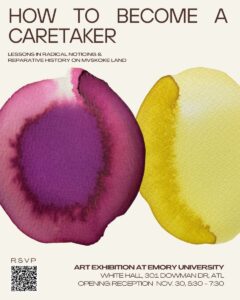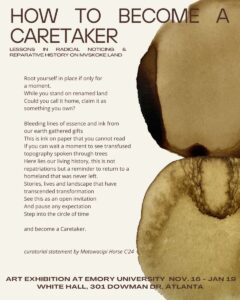On November 30, Artist Bird Harris and students from HIST-285: Intro to Native American History will be installing their semester-in-the-making project How to Become a Caretaker: Lessons in Radical Noticing and Reparative History on Mvskoke Land. Click here to register for the event.
As part of Emory’s Art & Social Justice program, students in HIST 285 have been learning how to see landscapes as living historical records. We’d like to invite you to our culminating exhibition which features collaborative artworks that are lessons in radical noticing and reparative history on Mvskoke land.
Curatorial text written by Matowacipi Horse C’24:
Recognizing the land as a living historical record tells us a story of transformation. We cannot stand here in the present moment without asking ourselves who has sustained, preserved and protected this land. As guests in a history still being written, students in HIST 285: Introduction to Native American History have created this exhibition to manifest physicality and action to Emory’s Land Acknowledgment “…Emory seeks to honor the Muscogee Nation and other Indigenous caretakers of this land by humbly seeking knowledge of their histories and committing to respectful stewardship of the land.”
Under the careful guidance of Dr. Loren Michael Mortimer and Bird Harris through Emory’s Arts and Social Justice Fellowship, students have been supported in asking how art can be a tool for expression, colonial resistance and education.
“How To Become A Caretaker” features works by Licia Brown, Matowacipi Horse, Anish Jha, Lydia Levy, Royce Mann, Jaanaki Radhakrishnan, Ted Wilson, Floyd Woolen and Bird Harris.
Time: 5:30 – 7:30 pm
Place: White Hall, 301 Dowman Dr NE


